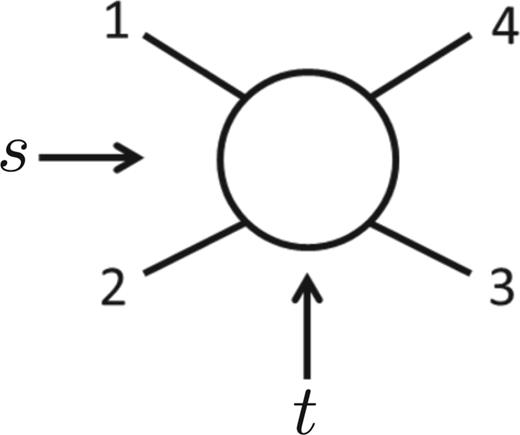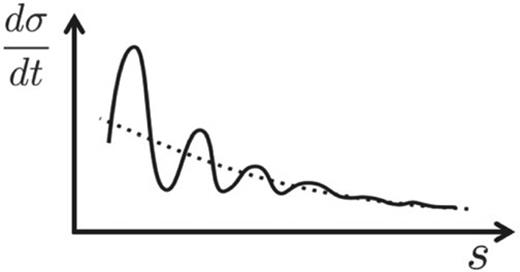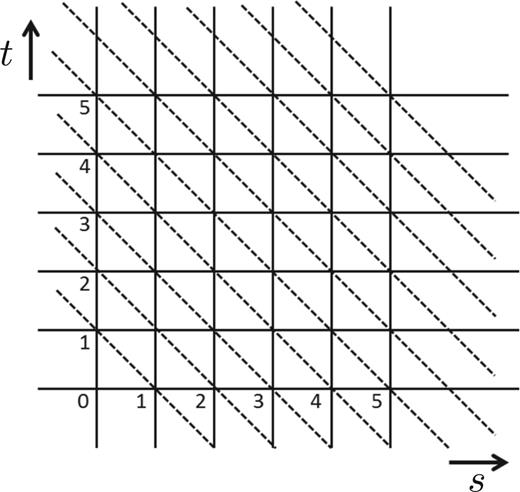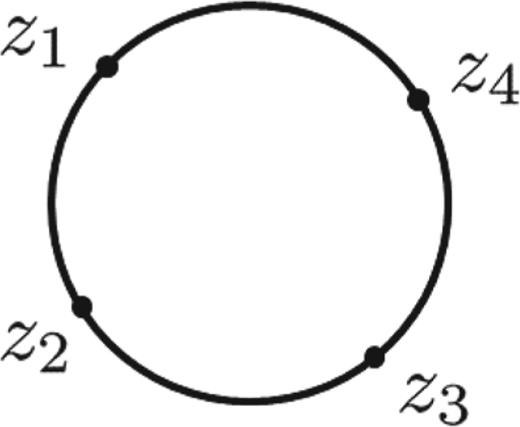Abstract
This is a brief summary of an introductory lecture for students and scholars in general given by the author at the Nambu Memorial Symposium which was held at Osaka City University on 29 September 2015. We review the invention of string theory by Professor Yoichiro Nambu following the discovery of the Veneziano amplitude. We also discuss Professor Nambu’s proposal on string theory in the Schild gauge in 1976, which is related to the matrix model of Yang–Mills type.
1. Introduction
In 1949, Professor Yoichiro Nambu started his career at Osaka City University where this memorial symposium was held. The idea of this symposium was to deliver the remarkable scientific achievements and originality of Professor Nambu throughout his life as much as possible to younger generations and scholars in general, so that some of what Nambu accomplished becomes more tangible. On 29 September 2015, ten speakers contributed to the idea of the symposium. The role of the author was to review the birth of string theory, which is a well-known unpublished (not contradictory) work [1] of Nambu. For pedagogical reasons as well as for the sake of presentation, the developments based on the path integral method before and after his work were included. In the latter part of the talk, a less well-known proposal of Nambu in the quantization and discretization of string theory in the Schild gaugein [2] was brought to the audience. This, in fact, testified to Nambu as a foreteller of modern physics. In order to setthe contextfor that proposal,we include a general discussion of matrix models.
2. Veneziano amplitude and Koba–Nielsen form
To begin, let us consider the
|$4$|-point scattering of scalar mesons. The Mandelstam variables are defined by
where
|$p^{\mu}_I$| are the momenta andthe symbol
|$\cdot$| denotes the Lorentz-invariant inner product inMinkowski space (see
Fig. 1). From experiments, the following facts were known (see
Fig. 2):

FIG 1.
4-point scattering of scalar mesons.
- ∘
The contribution of many particles (poles) in the |$t$| channel is evident.
- ∘
It suggests the structure of (mass)|$^2$| proportional to spin.
- ∘
The behavior in the region |$s \gg t$| is correlated with that in the region |$s \ll t$|.

FIG 2.
The differential cross section.
The idealization that one can take is that there exists an infinite number of such particles with (mass)|$^2 \propto $| spin,by setting |$N_0 \to \infty$| in Fig. 3.
The amplitude was empirically known to satisfy the relation |$f_{\rm exp}(s,t) = f_{\rm exp}(t,s)$|,which is denoted by  . Therefore, the behavior in the region where the first variable |$\gg$| the second variable determines that in the region where the first variable |$\ll$| the second variable.The sum of exchange of the resonance in the |$t$|-channelis equivalent to the sum of the resonance in the |$s$|-channel.
. Therefore, the behavior in the region where the first variable |$\gg$| the second variable determines that in the region where the first variable |$\ll$| the second variable.The sum of exchange of the resonance in the |$t$|-channelis equivalent to the sum of the resonance in the |$s$|-channel.
Veneziano [3] wrote down the amplitude satisfying these assumptionsand we will present the answer in a different way from his route. We will also review the developments where the solution was represented in such a way to be directly generalizable into |$4 \to n$|.

FIG 4.
The positions of a simple pole in (s,t) plane.
For a while, let us keep
|$N_0$| in
Fig. 3finite and ignore the dimension, pretending that the slope of each trajectory is one. We need a simple pole at
A naive multiplication of these pole factors, however, evidently leads us toa problem of overcounting atthose points where both
|$s$| and
|$t$| are integers. Multiplying the appropriate factors indicated by the dotted lines in
Fig. 4in order to remove this redundancy,we obtain
Here, we have introduced the factor
|$N_0!$| to render the
|$N_0 \to \infty$| limit finite. Taking this limit, we obtain
1By the replacement
|$s \to \alpha(s) = \alpha_0 + \alpha' s$|, we obtain

FIG 5.
Original four integration variables on the unit circle.
The reduction of the number of integration variables fromfour to the one variable
|$x$|is understood as the Möbius invariance acting on the unit circlein
Fig. 5. The cross ratiois defined by
and we regard
|$z_2, z_3, z_4$| to be fixed by the Möbius group rotations. After some manipulations, we obtain
where
In this form, we can readily generalize the four-point amplitude to|$n$| points just by changing |$4 \to n$| in the product. This is the Koba–Nielsen form [4].
Next, let us rewrite the last expression (
2.8)usingknowledgefrom two-dimensionalelectrostatics. Let us note that
and that
is the Neumann function in the unit disk
|$D$|. We can rewrite the exponent of the factor (
2.10) as
where
and the
|$z_I$|s are located on the boundary of the unit disk. This looks likes the (quantum)oscillations of
|$d$| scalar fields
|$X^{\mu}(z,\bar{z}),~ \mu= 0,1,\ldots, d-1$| on
|$D$| in two Euclidean dimensionswith such scalar fields path-integrated [
5]. The action, which is a weight upon the path integrations, is identified as
Undesirable states, however, appear in the canonical quantization. An infinite number of constraints, called Virasoro constraints [6],must be imposed.
3. Discovery of the Nambu–Goto string
According to author’s (certainly incomplete) search of references, several people other thanthe authors of [5] at that time worked out the harmonic oscillatorformalism to analyze the factorization and other properties of the Veneziano amplitude and reached the quadratic form of the action (2.14).Most notably, the picture of the rubber band was developed by Susskind [7–10].For contributions on these points from other people, including ones by unpublished reports, the author simply has no choice but to direct the readers to the references of the old review article [11] as well as those of the book [12].
Nambu [
1] and Goto [
13] adoptedthe area of the surface
|$\Sigma$| swept by a stringin
|$d$|-dimensional Minkowski spacetime as the action. The
|$d$| scalar fields introduced in Eq. (
2.14)play the role of the embedding function:
where
|$z = \xi^1 + i \xi^2 = e^{i(\sigma + \tau_M)}$|. The action is given by
where
|$\gamma_{ab} \equiv \partial_a X \cdot \partial_b X$| is the induced metric. Since this action has reparametrization invariance, the following two constraints can be imposed:
where
|$\dot{X} \equiv \frac{\partial X}{d \tau_M}, ~ X' \equiv \frac{\partial X}{\partial \sigma}$|. These are the Virasoro constraints. The action Eq. (
2.14) is reproduced using these.
The next stage of the developments took place more than ten years later. It came from our improved understanding of the quantization procedure based on an auxiliary field (two-dimensional metric)
|$g_{ab}(\xi)$|. The Nambu–Goto action is further rewritten in terms of intrinsic quantities of the two-dimensional surface swept by a string:
This form is suitedto the study of the quantum anomaly [14–16]. Let us note that the action |$S_P$| in Eq. (3.4) does not contain derivatives of |$g_{ab}$|. The equation of motion for |$X^{\mu}$| is the two-dimensional Laplace equation or the wave equation,whilethe equation of motion for |$g_{ab}$| is the Virasoro constraintsor the energy–momentum tensor |$= 0$| on the two-dimensional background metric.The action |$S_{NG}$| of Eq. (3.2) is reproduced from |$S_P$| by eliminating |$g_{ab}$|.
Anothermethod pursuedfor the quantization of the Nambu–Goto stringis the so-called Schild gauge:
where
|$\alpha$| and
|$\beta$| are constants and
is the Poisson bracket. When eliminating
|$\sqrt{-g}$| bythe equation of motion obtained from the variation
|$\delta{\sqrt{-g}}$|,the action
|$``S_{\rm Schild}"$| becomesproportional to
|$S_{NG}$|.
4. Path integral quantization of a string
Let us recall the bottom line of the path integral. The transition amplitude for one-particle quantum mechanics is given by
where
|$S$| is the action functional. This is essentially infinite-dimensional multiple integrals.
The path integral representation for the correlation function can be Wick rotated into
which is the same as the sum over all configurations with Boltzmann weights in statistical mechanics.
The Möbius invariant
|$n$|-point scattering amplitude can be written as
Let us now turn to the path integral quantization of a string. The path integrals over
|$X^{\mu}$| are essentially infinite-dimensionalmultiple integrals, each of which is a Gaussian.The question arisesas to how to treat the path integrals for
|$g_{ab}$|. Note that in computing
|$\sum_{{\text{configuration}}} \cdots e^{-S_E}$|, the sum should be taken over the gauge-inequivalent configurations alone. The idea of the computation is that we first carry out the summation, ignoring this double-counting problem, and then divide the answer by “the number of multiplicities,” namely, the volume of the gauge orbit (see
Fig. 6). The general variation of
|$g_{\mu\nu}$| is given by

FIG 6.
Gauge orbit and a gauge slice.
The firstterm is the diffeomorphism with the tracelessness condition imposed. The second term is the local Weyl transformation. These are the two local symmetries of the action (
3.4). The third term should be written as
|$\ker P_1^{\dagger}$| and corresponds to the degree of freedom called moduli of the surface deformation. Let us recall and indicate very briefly how we introduce the notion of integration in finite-dimensional Riemannian space with its metric given by
We need to work out the infinite-dimensional analog of this problem. Therefore, we have to estimate the Jacobian associated with the change of variables (4.4)[17, 18].
Skipping the remaining procedure, let us give the master formula for string perturbation theory for the case of a bosonic string. Here, we will consider the zero-point amplitude, namely, the partition function of a closed string only. The coupling constant of string theory is denoted by
|$\kappa$| and is introduced through
where
|$\Phi$| is the condensate of the dilaton. The order of string perturbation theory is determined by the Euler number
|$\chi(h,b,c)$| of the surface (
|$h$|,
|$b$|, and
|$c$| are the number of holes, boundaries, andcross caps, respectively) and string perturbation theory is, therefore, the genus expansion. The formula for the partition function reads
Fordetails of the notation, we refer the reader to [17, 18]. The critical dimension |$d=26$| is selected by demanding the decoupling of the Liouville degrees of freedom.
In the case of superstring perturbation theory, we first need to introduce fermions on the world-sheet [19–21], but we need to work out a lot more to construct the perturbative series. The critical dimension is |$d=10$|. Maximal spacetime supersymmetry is accomplished by the GSO projection [22],and the generalized GSO projection [23–25]or orbifolding [26] must beused in order to construct more realistic models having non-maximal supersymmetry. Eventually, spacetime supersymmetry must be broken and currently there is a revived interest (see, for instance, [27]) in the old work [28–30]. Turning to the more mathematical aspects, the construction of super Riemann surfaces (see, for instance, [31–35])as well as that of the super moduli hasmajor unfinished parts. See, for instance, [36] for recent progress.
5. Matrix model of Yang–Mills type and Nambu’s proposal
Matrix models are defined by
These are just finite-dimensional multiple integrals. There are two types: 1) the one matrix model and its extension to a chain of matrices;2) the Yang–Mills type.
The Haar measure of an
|$N \times N$| Hermitian matrix
|$M$| is given by
where
|$M = U^{\dagger} \Lambda U$| and
|$d\Omega = dUU^{\dagger}$|. The factor
|$\prod_{i>j}(\lambda_i-\lambda_j)^2$| works as a repulsive forcebetween the eigenvalues in providing the effective action of the model given.The eigenvalue distribution is expected to become continuous in the limit
|$N \to \infty$| and it can be regarded as a system of complex planes cut and glued, namely, the Riemann surface.
In the case of the one-matrix model, the simplest model of type 1), the equation of motion for the correlation functions(the Schwinger–Dyson equation) takes the form of the Virasoro constraints[37–40].For more general chain models, they typically obey |$W_n$|-type constraints[41]. The models of type 1) reduce to eigenvalue models as the angular integrations simply factor out. There are several physical contexts where the models of type 1) are relevant:
- (1)
The string theory where the Liouville factor |$g^a_a = 2\text{e}^{\phi}$| cannot be factorized[37, 42] (string theory in non-critical dimensions). Furthermore, in the case of |$d \leq 1$|, one can sum the perturbative series to treat some non-perturbative effect [43–45].
- (2)
Choosing a multi-log potential and an appropriate integration region (Selberg-type matrix model), and introducing the parameter |$\beta$| to modify the exponent of the measure factor (|$\beta$|-ensemble), the instanton sum has been generated (AGT relation [46]) [47, 48].
- (3)
Generation of the effective (super-)potential which describes the gluino condensation [49, 50].
- (4)
Actions of |$d=3$| and |$d=4$| supersymmetric gauge theories often reduce to matrix integrals (localization;see, for example, [51]). This has led to the study of instanton gas of various kinds (see, for example, [52]).
With regard to the matrix models of type 2), Professor Nambu had already made a remarkable proposalin 1977 in [
53] in string theory in the Schild gauge. In fact, the equation of motion for
|$X^{\mu}$| obtained from
|$``S_{\rm Schild}"$| in Eq. (
3.6) is
Let us quote Nambu’s proposal:
An interesting possibility that suggests itself is to take the Poisson bracket notation in Eq. (35) seriously, and go to its “quantum mechanics version”, by regarding the internal coordinates|$\tau$| and |$\sigma$| as non-commuting operators.It is totally unclear what this means, but we try it nevertheless...[53]
When the Poisson bracket
|$\{~,~\}_{\rm P.B.}$| and
|$X^{\mu}$|are replaced by
|$-i [~,~]$| and by the covariant derivative
|$D^{\mu} = \partial^{\mu} - igA^{\mu}$|, respectively, we in fact obtain an equation of motion for Yang–Mills fields:
The IIB matrix model [
54] was proposed in order to provide a complete treatmentof superstrings that includes non-perturbative effects.The action is given by
where
|$A^{\mu}~ (\mu=0,1,\ldots,9)$| are ten Hermitian matrices and
|$\psi_{\alpha}$| is a 16-component Majorana–Weyl spinor that takes values in an
|$N\times N$| Hermitian matrix. We have denoted by
|$\Gamma^{\mu}$| the 10-dimensional gamma matrices. The action (
5.5) is obtainedfrom the Green’schwarz action (
|$\theta_2 \to i\theta_2$|) in the Schild-type gaugeby the following replacements,
The bosonic part takes the same form as that proposed by Nambu. The many-body problem of strings can be treated by integrating out the off-diagonal blocks after dividing each of the original matrices into blocks. It appears, however, that there is no evidence that the gauge volume of the local Weyl symmetry is factored out, which is requisite for (perturbative) string theory in the critical dimension that ensures the masslessness of the graviton in flat spacetime.
Acknowledgments
The author (H.I.) was neither a postdoc nor a graduate student of Professor Yoichiro Nambu’s, but had the rare fortune of being relatively near at FNAL-Chicago, Osaka University, and Osaka City University in the last thirty years, and could know some of his thoughts and inspirations in depth. The author expresses his gratitude to Professor Nambu for providing him with insights as a scientist and tenderness as a human on various occasions.
Funding
Open Access funding: SCOAP3.
References
[1]
,
Duality and Hadrodynamics, notes prepared for Copenhagen High Energy Symposium
,
August
1970
.
[2]
,
Phys. Rev. D
16
,
1722
(
1977
).
[3]
,
Nuovo Cim. A
57
,
190
(
1968
).
[4]
and ,
Nucl. Phys. B
10
,
633
(
1969
).
[5]
, , and ,
Phys. Rev. D
2
,
2857
(
1970
).
[6]
,
Phys. Rev. D
1
,
2933
(
1970
).
[7]
,
Phys. Rev. Lett.
23
,
545
(
1969
).
[8]
,
Nuovo Cim. A
69
,
457
(
1970
).
[9]
,
Phys. Rev. D
1
,
1182
(
1970
).
[10]
, , and ,
Nucl. Phys. B
28
,
34
(
1971
).
[11]
,
Rev. Mod. Phys.
47
,
123
(
1975
).
[12]
, , and ,
Superstring Theory
(
Cambridge University Press
,
Cambridge
,
1987
),
Vol. 1
.
[13]
,
Prog. Theor. Phys.
46
,
1560
(
1971
).
[14]
,
Phys. Lett. B
103
,
207
(
1981
).
[15]
,
Phys. Rev. Lett.
42
,
1195
(
1979
).
[16]
,
Nucl. Phys. B
226
,
437
(
1983
).
[17]
,
Nucl. Phys. B
216
,
125
(
1983
).
[18]
and ,
Rev. Mod. Phys.
60
,
917
(
1988
).
[19]
and ,
Nucl. Phys. B
31
,
86
(
1971
).
[20]
,
Phys. Rev. D
3
,
2415
(
1971
).
[21]
and ,
Phys. Rev. D
8
,
440
(
1973
).
[22]
, , and ,
Nucl. Phys. B
122
,
253
(
1977
).
[23]
, , and ,
Phys. Rev. Lett.
57
,
1832
(
1986
).
[24]
, , and ,
Nucl. Phys. B
288
,
1
(
1987
).
[25]
, , and ,
Nucl. Phys. B
287
,
477
(
1987
).
[26]
, , , and ,
Nucl. Phys. B
261
,
678
(
1985
).
[28]
and ,
Nucl. Phys. B
153
,
61
(
1979
).
[29]
and ,
Nucl. Phys. B
274
,
93
(
1986
).
[30]
and ,
Phys. Lett. B
B186
,
129
(
1987
).
[31]
,
Phys. Lett. B
190
,
40
(
1987
).
[32]
, , and ,
Nucl. Phys. B
299
,
279
(
1988
).
[33]
, , and ,
Commun. Math. Phys.
119
,
129
(
1988
).
[34]
and ,
Nucl. Phys. B
291
,
256
(
1987
).
[35]
and ,
Nucl. Phys. B
293
,
685
(
1987
).
[36]
and ,
Proc. String-Math 2012, Bonn
,
Germany
,
July
16
–
21
,
2012
[
arXiv:1304.7798.
[37]
,
Mod. Phys. Lett. A
5
,
1019
(
1990
).
[38]
and ,
Phys. Lett. B
255
,
202
(
1991
).
[39]
and ,
Phys. Lett. B
252
,
47
(
1990
).
[40]
, , and Yu. ,
Phys. Lett. B
251
,
517
(
1990
).
[41]
, , and ,
Phys. Lett. B
265
,
99
(
1991
).
[42]
and ,
Nucl. Phys. B
321
,
509
(
1989
).
[43]
and ,
Phys. Lett. B
236
,
144
(
1990
).
[44]
and ,
Nucl. Phys. B
335
,
635
(
1990
).
[45]
and ,
Phys. Rev. Lett.
64
,
127
(
1990
).
[47]
and ,
Nucl. Phys. B
838
,
298
(
2010
) .
© The Author(s) 2016. Published by Oxford University Press on behalf of the Physical Society of Japan.
This is an Open Access article distributed under the terms of the Creative Commons Attribution License (
http://creativecommons.org/licenses/by/4.0/), which permits unrestricted reuse, distribution, and reproduction in any medium, provided the original work is properly cited.Funded by SCOAP
3
PDF



 . Therefore, the behavior in the region where the first variable |$\gg$| the second variable determines that in the region where the first variable |$\ll$| the second variable.The sum of exchange of the resonance in the |$t$|-channelis equivalent to the sum of the resonance in the |$s$|-channel.
. Therefore, the behavior in the region where the first variable |$\gg$| the second variable determines that in the region where the first variable |$\ll$| the second variable.The sum of exchange of the resonance in the |$t$|-channelis equivalent to the sum of the resonance in the |$s$|-channel.






